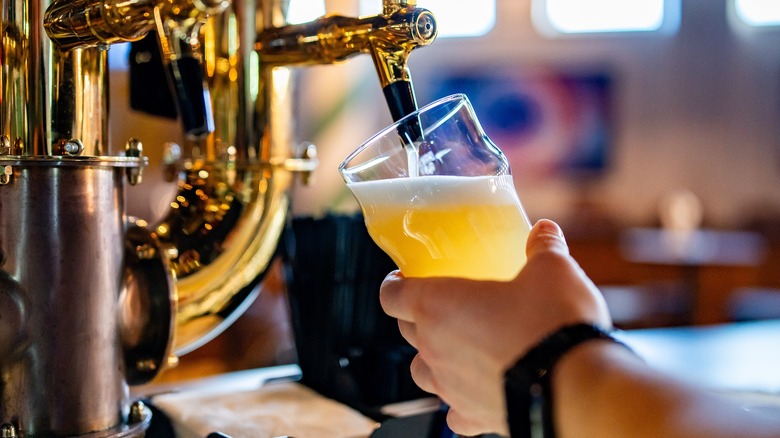How Long Is A Keg Good For Once It's Been Tapped?
There's no denying that draft beer tastes better than bottled or canned alternatives. The main reason draft beer is superior is simple — it's fresher than beer that's been prepackaged. Or at least, it should be.
The length of time that kegged beer remains fresh can depend on a few factors. Different styles of beer will lose their freshness at varying rates. The main thing that determines how long an unopened keg will last is whether the beer has been pasteurized, meaning the liquid has been heat-treated to kill pathogens and extend its shelf life. Assuming the keg is stored correctly, pasteurized beer will stay fresh between 90 and 120 days, while unpasteurized beer should be consumed between 45 to 60 days.
Breweries typically stamp kegs with a fill date, a "best before" date, or both to help us keep track. In a perfect environment, kegs that are tapped using a CO2-based dispense system should stay fresh for the same amount of time as if they were unopened, as the beer isn't exposed to oxygen. However, using a manual "party pump" is a different story. In this case, the beer gets exposed to more oxygen with every pour, meaning it can taste papery and stale in as little as 12 to 24 hours. The other exception is what's known as cask ale or "real ale." A popular style in places like the U.K., these beers are kegged with live yeast cultures and can turn stale in as little as three days.
How to keep kegged beer fresher for longer
The expiration date of a keg assumes the beer is being stored in the right environment. If it isn't, the beer will lose its freshness more rapidly, begin developing off flavors, and expire more quickly. Although expired beer is unlikely to make you sick in the way other out-of-date food and drink can, you should still want a keg of beer to maintain its quality for as long as possible. Fortunately, this is easily achievable when you're aware of what impacts beer freshness.
Temperature is the most important element for keeping kegged beer fresh. Kegs should be stored at 38 degrees Fahrenheit at all times, which is why they're transported in refrigerated trucks. If the beer becomes too warm, we run into a couple of issues. First, bacteria can begin to grow if the beer exceeds 55 degrees Fahrenheit. Second, warm beer can become too foamy, meaning it becomes stale faster, and you end up with more wastage when you're trying to pour a pint. That said, you also want to be careful about serving beer that's too cold. Although an average-strength beer doesn't freeze until around 28 degrees Fahrenheit, low temperatures mask flavor. This isn't a huge issue for mass-produced lagers — these styles are often served ice-cold for refreshment and aren't known for their bold taste. However, for more flavorsome styles such as stouts and IPAs, it's important to make sure their nuanced characteristics can still be enjoyed.

